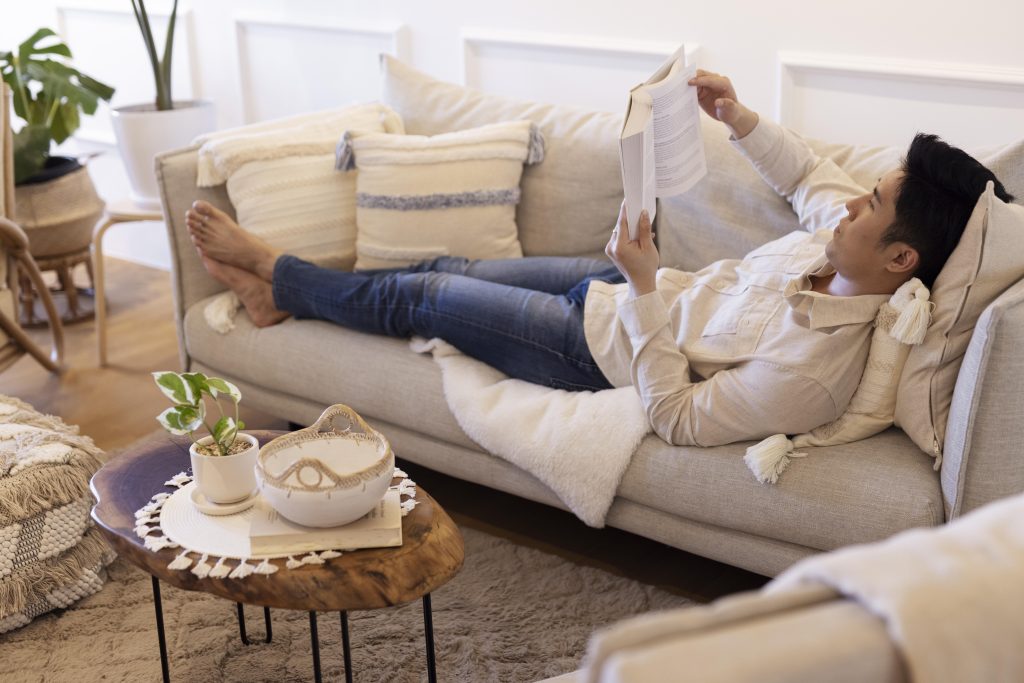Mindful Home Design for Comfortable Living
Jessica White August 15, 2025
In today’s fast-paced world, the idea of a home extends beyond simply being a shelter; it is an essential space for comfort, well-being, and personal growth. Mindful home design has emerged as a key trend, emphasizing spaces that are both functional and healing. By incorporating principles of mindfulness and wellness into home design, we can transform our living spaces into environments that nurture the mind, body, and spirit.

What Is Mindful Home Design?
Mindful home design is about creating spaces that enhance well-being, encourage relaxation, and promote mental and physical health. This approach combines aesthetics with intentional design elements, such as natural materials, thoughtful layouts, and the incorporation of nature, all while focusing on emotional comfort.
Unlike traditional interior design that might prioritize style or function alone, mindful design seeks to align both the aesthetic and the functional to create a space that supports a healthy and calm lifestyle.
Why Mindful Design Is Gaining Popularity
With rising awareness around mental health, mindfulness, and sustainability, mindful home design has become increasingly popular. The past few years have seen a surge in interest, especially with more people working from home and seeking environments that offer peace, stability, and inspiration. Furthermore, after spending significant time at home during the pandemic, many individuals have realized the profound impact that their living spaces have on their mental health.
Some of the reasons why mindful design is trending include:
- Improved Mental Health: A cluttered or disorganized environment can negatively impact mental well-being. Mindful design fosters a sense of tranquility, helping to reduce stress and anxiety.
- Increased Comfort: Prioritizing comfort in the design, such as ergonomic furniture, soft textiles, and relaxing color schemes, makes the home feel like a sanctuary.
- Sustainability: As mindfulness often includes a sense of responsibility for one’s environment, many mindful designs incorporate sustainable materials and eco-friendly features, contributing to a healthier planet.
- Connection to Nature: The biophilic design trend, a central element of mindful home design, brings nature indoors, which has been shown to improve mood and productivity.
Key Elements of Mindful Home Design
- Maximizing natural light is one of the simplest ways to create a mindful home. Large windows, skylights, and open spaces allow natural light to fill the home, which can improve mood, regulate circadian rhythms, and enhance overall well-being. Good airflow and ventilation also play a key role in maintaining a healthy indoor environment by improving air quality.
- Incorporating natural materials like wood, stone, bamboo, and cotton helps to connect the indoors with nature. These materials not only add beauty but also promote calm and comfort. Natural finishes, such as untreated wood floors or stone countertops, provide warmth and texture, enhancing the space’s peaceful atmosphere.
- Mindful design also emphasizes decluttering and organizing. A cluttered environment can lead to stress, whereas a well-organized, minimalist space fosters a sense of control and calm. Storage solutions like built-in shelves, multifunctional furniture, and open storage reduce clutter and enhance relaxation.
- Designating specific spaces for wellness activities—such as meditation, yoga, or reading—supports mindfulness. These areas should be quiet and comfortable, with soft lighting, cozy seating, and calming colors to set the mood for relaxation.
- Biophilic design, which connects the home to nature through plants, natural light, water features, and even natural sounds, has been shown to reduce stress and improve mood and cognitive function. Incorporating greenery and natural elements throughout the home maintains this essential connection to nature.
- Color psychology also plays a crucial role in mindful design. Calming tones like greens, blues, and earth tones create relaxation zones, while energizing colors in workspaces stimulate creativity and focus.
- Lastly, sustainable materials, such as bamboo, recycled glass, and non-toxic paints, contribute to both environmental health and personal wellness, ensuring a healthier, eco-friendly living space.
Benefits of Mindful Home Design
- Reduces Stress: A space designed with mindfulness can directly impact your mental state, helping reduce feelings of stress and overwhelm.
- Enhances Comfort: Comfort isn’t just about plush sofas—it’s about creating a space that feels inviting and nurturing on every level, from lighting to furniture layout.
- Boosts Productivity: A well-organized, light-filled, and calming environment can improve concentration, creativity, and overall productivity.
- Improves Sleep: Bedrooms designed with tranquility in mind, such as with blackout curtains and soothing colors, can promote better sleep hygiene and restful nights.
- Encourages Healthy Habits: Spaces that facilitate physical activities like yoga or provide easy access to outdoor spaces can encourage healthier lifestyles.
Practical Tips for Implementing Mindful Design
- Start with One Room: If overhauling your entire home feels overwhelming, start with a single room. The bedroom is a great place to begin, as it’s your sanctuary for rest and rejuvenation.
- Incorporate Your Personal Touch: Mindful design should feel authentic. Incorporate elements that bring you joy and comfort, whether it’s a favorite piece of art or a treasured family heirloom.
- Simplify Your Decor: Choose fewer but more meaningful pieces. Items that evoke positive emotions or serve a practical purpose can go a long way in maintaining a calm atmosphere.
- Focus on the Senses: Consider all five senses when designing your space. Choose fabrics that feel soft, incorporate pleasant scents with essential oils or candles, and use sounds, like a water feature, to create a serene atmosphere.
- Invest in Quality over Quantity: Mindful design doesn’t mean filling your home with expensive items. It’s about choosing fewer, higher-quality items that provide a sense of well-being.
Conclusion
Mindful home design isn’t just a trend; it’s a movement toward creating living environments that prioritize wellness, comfort, and sustainability. By integrating natural elements, focusing on simplicity, and creating spaces for relaxation and connection with nature, mindful design can enhance both your physical and mental health. As we continue to spend more time in our homes, taking the time to design these spaces with intention can have lasting benefits for both our homes and our well-being.
References
- Beal, B. (2022, September 15). How mindful design can improve your home’s wellness. The Spruce. Available at: https://www.thespruce.com (Accessed: 15 August 2025).
- Day, D. (2023, January 10). Creating calm: Mindful home design for better mental health. MindBodyGreen. Available at: https://www.mindbodygreen.com (Accessed: 15 August 2025).
- Hanks, C. (2021, July 7). The benefits of biophilic design in the modern home. Architectural Digest. Available at: https://www.architecturaldigest.com (Accessed: 15 August 2025).






